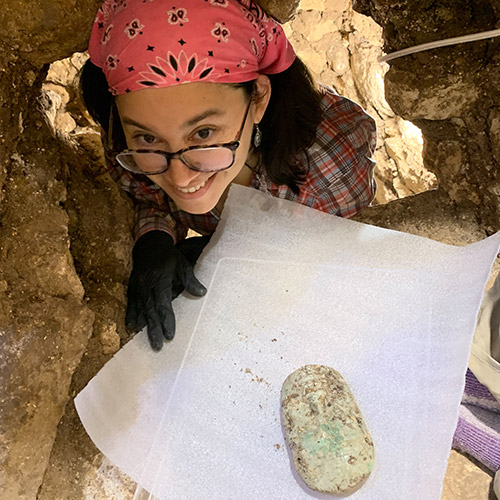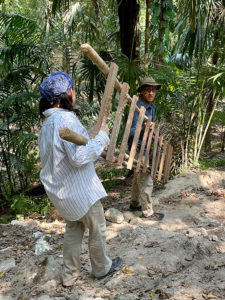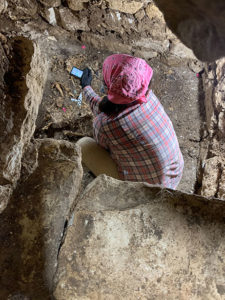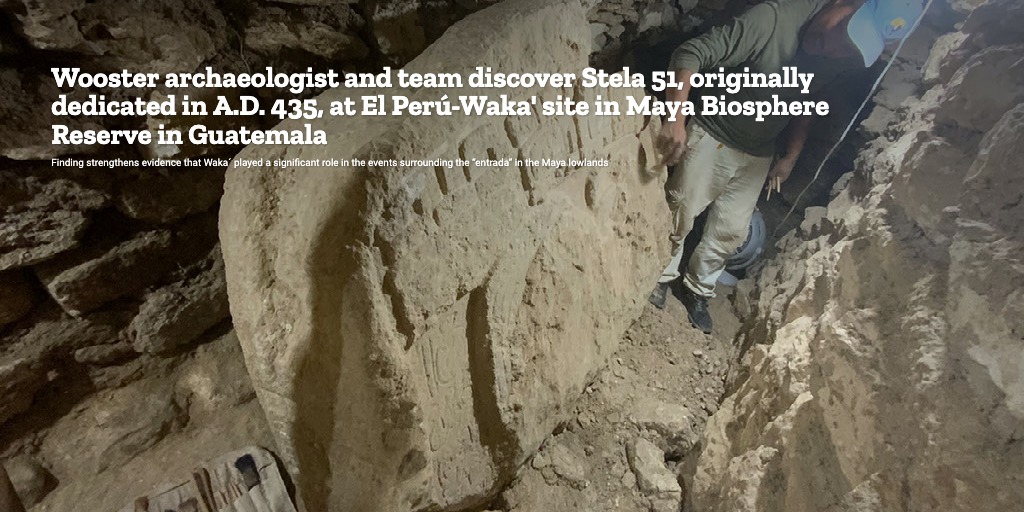
Wooster’s Navarro-Farr and Proyecto Arqueológico Waka’ team discover Stela 51 and Burial 110: a royal tomb at El Perú-Waka’ site in Maya Biosphere Reserve in Guatemala

Olivia C. Navarro-Farr, associate professor of archaeology and anthropology at The College of Wooster and co-director of the Proyecto Arqueológico Waka’ (PAW) team from the archaeological site of El Perú-Waka´ located in the Laguna del Tigre National Park within the Maya Biosphere Reserve in Guatemala celebrated two significant discoveries after her work this year. See videos and more images of the team’s work to uncover these impressive features here.
The Ministry of Culture and Sports of Guatemala and the Proyecto Arqueológico Waka’ announced the first discovery, Stela 51, as the second earliest dated monument thus far discovered at the archaeological site. It was found incorporated into the building’s late-phase architecture (roughly from between the late 8th to the early 11th century A.D.) meaning it had been re-interred into a phase of the building that dates centuries after the monument was actually commissioned (in A.D. 435). In an earlier substructure or phase of the building, dating to the same period as the commissioning of Stela 51 (the Early Classic, about A.D. 250-500), the team investigated an ancient tunnel penetrating the wall directly over a protruding platform. In that investigation, archaeologists revealed a small opening amidst a layer of capstones inside the structure which led to the discovery of Burial 110, a royal tomb.
“We are definitely seeing with recent evidence that the site, politically, was a very major player in the Early Classic period and in the Late Classic period,” said Navarro-Farr. “The waves that this will make in the community of Maya epigraphy, will be significant. It is going to be a very much studied, and restudied, and restudied monument because of the texts that are on it.”
 The ancient city of Waka’ located within the Laguna del Tigre National Park which is itself inside the Maya Biosphere Reserve is the location of a great number of archaeological zones of immense importance to Guatemala’s cultural heritage. Navarro-Farr has been the principal investigator for investigations within Structure M13-1, the monumental civic-ceremonial building where these discoveries were made, since 2003. She is co-director of the Proyecto Arqueológico Waka’ (PAW) with Damien Marken of Bloomsburg University of Pennsylvania, and Juan Carlos Pérez Calderón, affiliated with the University of San Carlos of Guatemala. Her investigations at Structure M13-1 were undertaken collaboratively with Pérez Calderón, and Griselda Pérez Robles, also affiliated with the University of San Carlos of Guatemala.
The ancient city of Waka’ located within the Laguna del Tigre National Park which is itself inside the Maya Biosphere Reserve is the location of a great number of archaeological zones of immense importance to Guatemala’s cultural heritage. Navarro-Farr has been the principal investigator for investigations within Structure M13-1, the monumental civic-ceremonial building where these discoveries were made, since 2003. She is co-director of the Proyecto Arqueológico Waka’ (PAW) with Damien Marken of Bloomsburg University of Pennsylvania, and Juan Carlos Pérez Calderón, affiliated with the University of San Carlos of Guatemala. Her investigations at Structure M13-1 were undertaken collaboratively with Pérez Calderón, and Griselda Pérez Robles, also affiliated with the University of San Carlos of Guatemala.
Found within Structure M13-1, a monumental civic-ceremonial structure in the site center, the Stela was broken into two fragments: the team discovered the lower section standing 2.4 meters in height in 2019. This fragment features hieroglyphic inscriptions and the image of a standing figure. In March of 2022, they discovered the second fragment, 1.20 meters in height, behind the upright lower portion of the monument in the same network of excavation tunnels. The second fragment features the upper part of the monument, including part of the face of the standing figure as well as a grand headdress in the form of a jaguar adorned with large feathers. As a whole, Stela 51 depicts a standing male dressed as a Teotihuacán warrior wearing a feline headdress and carrying a rectangular shield. Teotihuacán was a great city in the Valley of Mexico 800 km west of the Maya lowlands.
 As they continued to define the architecture of the structure, archaeologists came upon a feature that led them to what was designated as Burial 110. This royal tomb includes human remains, vessels, artifacts, and worked jade. Some items are rendered in a style linked to Teotihuacán, an ancient Mesoamerican city located 50 km northeast of modern-day Mexico City. “Much remains to be seen at this point but preliminarily what we know is that it’s Early Classic in date from the diagnostics of the ceramics that we’ve seen, and we can say that the individual who’s interred there is really an important ancestral figure….,” said Navarro-Farr, continuing to explain the importance of the structure as a place of reverence and ceremony. “There’s definitely more to come in the years ahead, and we’re really, really excited about what an incredible season we’ve had this year.” More information about Navarro-Farr and her work is available here. Look for a full documentary with more about the Proyecto Arqueológico Waka´ and their work coming soon.
As they continued to define the architecture of the structure, archaeologists came upon a feature that led them to what was designated as Burial 110. This royal tomb includes human remains, vessels, artifacts, and worked jade. Some items are rendered in a style linked to Teotihuacán, an ancient Mesoamerican city located 50 km northeast of modern-day Mexico City. “Much remains to be seen at this point but preliminarily what we know is that it’s Early Classic in date from the diagnostics of the ceramics that we’ve seen, and we can say that the individual who’s interred there is really an important ancestral figure….,” said Navarro-Farr, continuing to explain the importance of the structure as a place of reverence and ceremony. “There’s definitely more to come in the years ahead, and we’re really, really excited about what an incredible season we’ve had this year.” More information about Navarro-Farr and her work is available here. Look for a full documentary with more about the Proyecto Arqueológico Waka´ and their work coming soon.
Photo 1: Navarro-Farr turns over a jade mask found within the tomb for the first time to reveal to members of the Proyecto Arqueológico Waka’.
Photo 2: Co-directors of Proyecto Arqueológico Waka’ Olivia C. Navarro-Farr and Juan Carlos Pérez Calderón set up a ladder to use to climb in and out of the palace tunnels.
Photo 3: Professor Navarro-Farr captures images of Burial 110.
All images are courtesy of the Ministry of Culture and Sports of Guatemala and the Proyecto Arqueológico Waka’.

Posted in Faculty, News on August 2, 2022.
Related Posts
Related Areas of Study
Archaeology
Fieldwork and research are a big part of the study of prehistoric and historical archaeology
Major MinorAnthropology
Use problem-solving and research skills to explore and understand communities and cultures in every part of the world.
Major Minor

